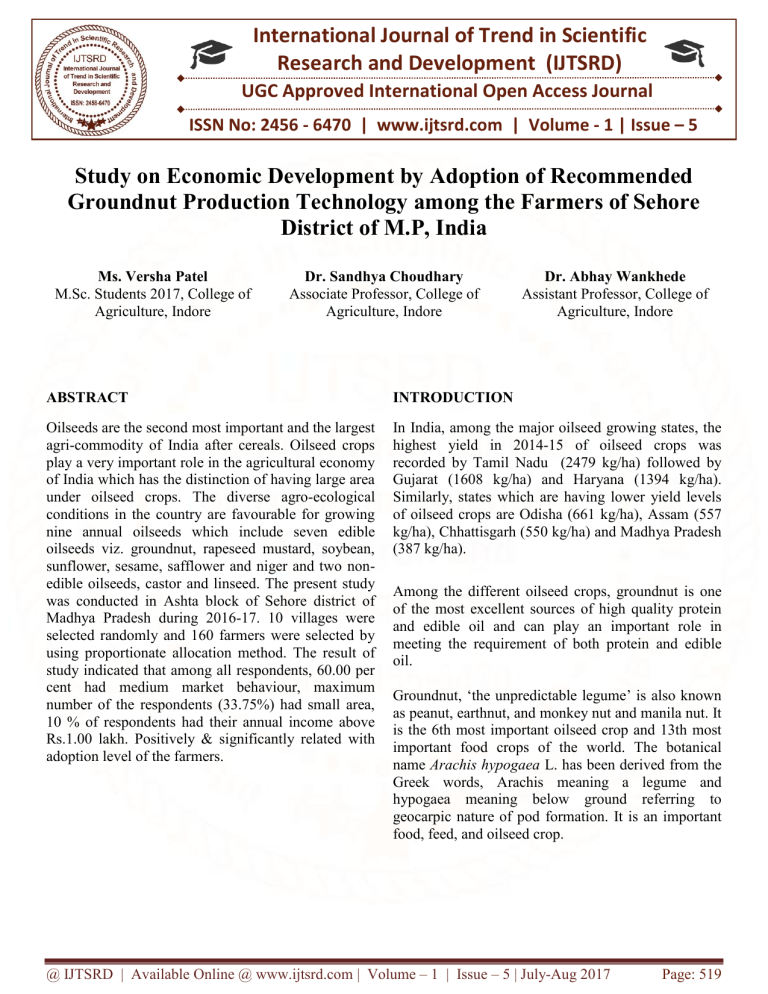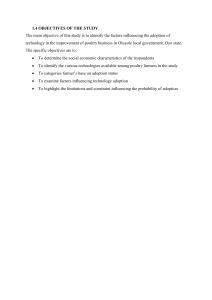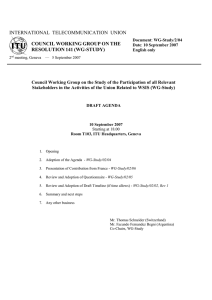
International Journal of Trend in Scientific
Research and Development (IJTSRD)
UGC Approved International Open Access Journal
ISSN No: 2456 - 6470 | www.ijtsrd.com | Volume - 1 | Issue – 5
Study on Economic Development by Adoption of Recommended
Groundnut Production Technology among the Farmers of Sehore
District of M.P, India
Ms. Versha Patel
M.Sc. Students 2017, College of
Agriculture, Indore
Dr. Sandhya Choudhary
Associate Professor, College of
Agriculture, Indore
Dr. Abhay Wankhede
Assistant Professor, College of
Agriculture, Indore
ABSTRACT
INTRODUCTION
Oilseeds are the second most important and the largest
agri-commodity of India after cereals. Oilseed crops
play a very important role in the agricultural economy
of India which has the distinction of having large area
under oilseed crops. The diverse agro-ecological
conditions in the country are favourable for growing
nine annual oilseeds which include seven edible
oilseeds viz. groundnut, rapeseed mustard, soybean,
sunflower, sesame, safflower and niger and two nonedible oilseeds, castor and linseed. The present study
was conducted in Ashta block of Sehore district of
Madhya Pradesh during 2016-17. 10 villages were
selected randomly and 160 farmers were selected by
using proportionate allocation method. The result of
study indicated that among all respondents, 60.00 per
cent had medium market behaviour, maximum
number of the respondents (33.75%) had small area,
10 % of respondents had their annual income above
Rs.1.00 lakh. Positively & significantly related with
adoption level of the farmers.
In India, among the major oilseed growing states, the
highest yield in 2014-15 of oilseed crops was
recorded by Tamil Nadu (2479 kg/ha) followed by
Gujarat (1608 kg/ha) and Haryana (1394 kg/ha).
Similarly, states which are having lower yield levels
of oilseed crops are Odisha (661 kg/ha), Assam (557
kg/ha), Chhattisgarh (550 kg/ha) and Madhya Pradesh
(387 kg/ha).
Among the different oilseed crops, groundnut is one
of the most excellent sources of high quality protein
and edible oil and can play an important role in
meeting the requirement of both protein and edible
oil.
Groundnut, ‘the unpredictable legume’ is also known
as peanut, earthnut, and monkey nut and manila nut. It
is the 6th most important oilseed crop and 13th most
important food crops of the world. The botanical
name Arachis hypogaea L. has been derived from the
Greek words, Arachis meaning a legume and
hypogaea meaning below ground referring to
geocarpic nature of pod formation. It is an important
food, feed, and oilseed crop.
@ IJTSRD | Available Online @ www.ijtsrd.com | Volume – 1 | Issue – 5 | July-Aug 2017
Page: 519
International Journal of Trend in Scientific Research and Development (IJTSRD) ISSN: 2456-6470
Table- State-wise area, production and yield of groundnut in 2013-14
S.N.
1.
2.
3.
4.
5.
6.
7.
8.
9.
10.
State
Andhra Pradesh
Gujarat
Karnataka
Madhya Pradesh
Maharashtra
Odisha
Rajasthan
Tamil Nadu
Uttar Pradesh
West Bengal
Others
All India
Area
(Lakh ha)
13.86
18.42
7.25
2.00
2.67
0.58
4.66
3.42
0.96
0.79
0.66
55.27
Production
(Lakh tonnes)
12.34
49.18
6.58
1.98
3.25
0.8
9.06
9.62
0.86
2.02
1.04
96.73
Yield
(kg/ha)
890
2670
908
990
1217
1379
1944
2813
896
2557
1576
1750
Source: Directorate of Economics and Statistics, Department of Agriculture and Cooperation
A research had therefore been planned to study’ Study
on economic development by adoption of
recommended groundnut production technology
among the farmers of Sehore district of M.P, India
Objective
To see the impact of extent of adoption of
recommended groundnut production technology by
the farmers on their economic status
technology earned more income annually compared to
adopters.
Kumar (2011) found that majority (73.33%) of the
respondents were having their annual income between
Rs.50000 to Rs.200000 followed by 15.00 per cent of
respondents who were having their annual income
below Rs 50000. Whereas, 11.67 percent of
respondents were having their annual income above
Rs 2 lacs.
Review of Literature
Marketing Behaviour
Area of Groundnut
Kumar (2011) found that maximum number of the
respondents (41.67%) had large size of land holding
(above 4 ha), followed by 25.00 per cent respondents
who belonged to small size of land holding (1 to 2
ha), whereas 17.50 per cent of the respondents were
having medium size of land holding (2.1 to 4 ha)
however only 15.83 per cent respondents belonged
under marginal category (less than 1 ha).
Reddy and Shenoy (2013) observed that majority of
groundnut farmers were average land holding (2-5
acres).
Annual Income
Mugisha et al. (2004) concluded that non- adopters of
groundnut production
Shukla and Gupta (2011) the marketing behaviour of
growers in Jaipur and outlines the constraints they
face in production and marketing. (based on data
collected from 120 farmers during 2006-07)
Jyothi and Anand (2013) revealed that majority of
FLD
farmers
fully
adopted
recommended
technologies in groundnut cultivation. Whereas,
majority of non-FLD farmers adopted the practices
like land preparation, seed rate, season and
intercultural operations, while, majority of them not
used rhizobium, PSB and gypsum.
Material & Method
The present study was conducted in Ashta block of
Sehore district of Madhya Pradesh during 2016-17. 10
villages were selected randomly and 160 farmers were
@ IJTSRD | Available Online @ www.ijtsrd.com | Volume – 1 | Issue – 5 | July-Aug 2017
Page: 520
International Journal of Trend in Scientific Research and Development (IJTSRD) ISSN: 2456-6470
selected by using proportionate allocation method.
The study was conducted with objectives to measure
the knowledge and extent of adoption of farmers
about recommended groundnut production technology
in adoption of production technology. One hundred
and sixty farmers were selected as the sample for
study. The data was collected by personal interview
with the help of structured schedule.
Sr.
No.
Category
1.
Low income
2.
Medium
income
3.
High income
Dependent Variable
Extent of Adoption of recommended groundnut
production technology by the farmers
It is mental process through which an individual
passes from hearing about an innovation to final
adoption (Rogers, 1995).
It was operationalized as the degree of the use of
recommended practices. Adoption refers to the extent
of use of recommended farming practices of
groundnut cultivation by farmers. To measure the
extent of adoption of recommended groundnut
production technology an interview schedule was
prepared with 16 questions.
Score
assigned
Income
( Up to Rs 50,000/)
(Rs. 50,001 to
1,00,000/-)
(Above Rs.
1,00,000)
1
2
3
3- Marketing behaviour
The data regarding the marketing behaviour were
collected from the respondents on 3 point continuum
scale namely least , medium and high proportion, the
score was given in order 1,2 and 3, respectively.
Sr. No.
1.
2.
3.
Proportion
Least
Medium
High
Score assigned
1
2
3
Result & Discussion
1-Area of groundnut
Independent variables
1-Area of groundnut
It refers to the number of hectare land possessed by
the farmer:
Sr.
No.
1
2
3
4
Category
Land holding
Marginal
Small
Medium
Large
Up to 1 ha.
1.01 to 2 ha.
2.01 to 4 ha.
4.01 ha and above
Score
assigned
1
2
3
4
It refers to number of hectares of land owned and
operated by the farmers. It largely determines the
socio-economic status of family and source of
livelihood. The data of the present investigation in
this regard have been presented in Table 4.4.
Table - Distribution of the respondents according
to their area of groundnut
Sr.
No.
1.
Category
Marginal
2.
Small
2-Annual Income
3.
Medium
Annual income of respondent refers to the total sum
amount received by all the sources in the year. It is
generally considered a primary measure of a nation’s
financial prosperity. On the basis of data collected, the
respondents were classified into following three
categories:
4.
Large
Total
Area of
groundnut
Up to 1 ha.
1.01 to 2
ha.
2.01 to 4
ha.
4.01 ha and
above
Frequency
Percentage
29
18.13
54
33.75
44
27.50
33
20.62
160
100
It is apparent from the Table 4.4 that the maximum
number of the respondents (33.75%) had small area
(1.1 to 2 ha), followed by 27.50per cent respondents
who belonged to medium area of land holding,
whereas 20.62 per cent of the respondents were
@ IJTSRD | Available Online @ www.ijtsrd.com | Volume – 1 | Issue – 5 | July-Aug 2017
Page: 521
International Journal of Trend in Scientific Research and Development (IJTSRD) ISSN: 2456-6470
having large area of groundnut and only 18.13 per
cent respondents belonged under marginal area
category. It could be concluded that maximum
number of respondents belonged to small area of
groundnut category.
having their annual income above Rs.1.00 lakh. The
results clearly indicated that majority of the
respondents belonged to Rs.0.50 to 1.00 lakh annual
income group.
3-Marketing Behaviour
2-Annual income
Marketing behaviour refers to groundnut grower
adoption about marketing conditions i.e. period of
selling, to whom it is sold, which marketing channel
have been used etc. Categorization of marketing
behaviour has been done under following categories
i.e. low, medium and high.
Annual income of farm family refers to the total sum
amount received by all the sources in the year. It
describes the economic condition of human beings.
Categorization of annual income as low, medium and
high has been given as below:
Table - Distribution of respondents according to
their annual income
Sr.
No.
1.
2.
3.
Category
Frequency
Percentage
Low (below 0.50
lakh)
Medium (0.511.00 lakh)
High (above
1.00 lakh)
33
20.63
111
69.37
16
10.00
Total
160
100
It was found that majority (69.37%) of the
respondents had their annual income between Rs.0.51
to 1.00 lakh, followed by 20.63 per cent of
respondents who had annual income below to Rs.0.50
lakh. Whereas 10.00 per cent of respondents were
Sr.
No.
1.
2.
3.
Category
Low
Medium
High
Total
Frequency
Percentage
38
96
26
160
23.75
60.00
16.25
100
Table -Distribution of respondents according to
their marketing
The data of Table 4.6 revealed that among all
respondents, 60.00 per cent had medium market
behaviour, followed by 23.75 per cent had low and
16.25 per cent respondents had high marketing
behaviour. Thus it may concluded that the highest
60.00 per cent of farmers had medium proportion
marketing behaviour.(Fig.6)
Table - Distribution of respondents according to their marketing behaviour
Sr. No.
Marketing behaviour
Frequency
Percentage
A.
Period of selling the produce
1.
Immediately after the harvest
47
29.38
2.
After one or two month of harvest by storing
34
21.25
3.
At the time of prices are favourable
79
49.37
160
100
To village level trader
68
42.50
To wholesalers through commission agent in the
regular market yard
41
25.63
Total
B.
1.
2.
Whom do you sell the produce
@ IJTSRD | Available Online @ www.ijtsrd.com | Volume – 1 | Issue – 5 | July-Aug 2017
Page: 522
International Journal of Trend in Scientific Research and Development (IJTSRD) ISSN: 2456-6470
3.
To the trader through the Co-op Society.
36
22.50
4.
To the Govt. Agencies
15
09.37
160
100
Total
C.
Which of the marketing channels would you
prefer?
1.
Directly to consumer
33
20.63
2.
To commission agent
29
18.12
3.
To whole seller
56
35.00
4.
To consumer enterprise
24
15.00
5.
To retailer
18
11.25
160
100
Total
The data presented in the Table 4.7 showed the
distribution of the respondents with respect to their
frequency of marketing behaviour separately. The
Maximum number of the respondents (49.37%) of the
respondents had sold the produce at the time when
prices were favourable, followed by 42.50 per cent
had sold the produce to village level trader, 35.00 per
cent of the respondents had used to whole seller as
marketing channel.
Extent of Adoption of the Farmers
1. Adoption regarding preparation of land
Table 4.15 showed that majority of the respondents
76.25 per cent pertained medium adoption regarding
preparation of land. Preparation of land is very
important practice for the production. Farmers did
their work according to their knowledge and adopted
it.
2. Adoption regarding time of sowing
Table 4.15 showed that majority of the respondents
75.00 per cent pertained complete adoption regarding
time of sowing. Farmers had complete knowledge
about time of sowing and farmers completely adopted
it.
3. Adoption regarding use of improved varieties
Table 4.15 showed that majority of the respondents
47.50 per cent pertained partial adoption regarding
use of improved varieties. Farmers had medium
knowledge about improved varieties, but they did not
know the source of purchasing so their adoption level
was low. High prices of improved variety were also a
reason of low adoption.
4. Adoption regarding seed treatment
Table showed that majority of the respondents 59.38 per
cent pertained partial adoption regarding seed treatment.
Farmers do not know the benefits of seed treatment and
hence it increased the cost of cultivation of the farmer.
5. Adoption regarding seed rate
Table showed that majority of the respondents 68.12
per cent pertained complete adoption regarding seed
rate, because farmers had complete knowledge about
it.
6. Adoption regarding spacing
Table showed that majority of the respondents 62.50
per cent pertained medium adoption regarding
spacing. Proper sowing increased yield and farmers
knew it, so the adopted it as per their knowledge.
7. Adoption regarding intercropping
Table showed that majority of the respondents 62.50
per cent pertained partial adoption regarding
intercropping. Farmers did not adopt the intercropping
because some harvesting and holding problem were
faced by the farmers.
@ IJTSRD | Available Online @ www.ijtsrd.com | Volume – 1 | Issue – 5 | July-Aug 2017
Page: 523
International Journal of Trend in Scientific Research and Development (IJTSRD) ISSN: 2456-6470
8. Adoption regarding use of manure
Table showed that majority of the respondents 50.63
per cent pertained medium adoption regarding use of
manure. Farmers knew the benefits of manure, so they
used it.
Table showed that majority of the respondents 46.87
per cent pertained medium adoption regarding insect
pest management. Farmers did insect pest
management as per their knowledge.
9. Adoption regarding fertiliser use
Table showed that majority of the respondents 61.88
per cent pertained medium adoption regarding
fertiliser use. Farmers had medium knowledge and
they used fertilizer as per their knowledge.
14. Adoption regarding diseases management
Table showed that majority of the respondents 47.50
per cent pertained medium adoption regarding
diseases management. Farmers had medium
knowledge about it, so they adopted it at medium
level.
10. Adoption regarding water management
Table showed that majority of the respondents 35.63
per cent pertained medium level of regarding water
management. Farmers followed this practice as per
the crop plant requirement.
15. Adoption regarding harvesting practices
Table showed that majority of the respondents 66.25
per cent pertained complete adoption regarding
harvesting practices. Farmers did all their work
according to their knowledge.
11. Adoption regarding weed management
The perusal of data presented in Table showed that
majority of the respondents 50.63 per cent pertained
medium adoption regarding weed management.
Farmers followed this practice as per their knowledge.
16. Adoption regarding storage
Table showed that majority of the respondents 61.25
per cent pertained partially adoption regarding
storage. Farmers followed their knowledge and earned
more profit from their production
12. Adoption regarding earthing up
Table showed that majority of the respondents 68.12
per cent pertained partial adoption regarding earthing
up. Farmers did not have knowledge about the
earthing up and its benefits. This practice resulted in
extra labour cost, so farmers did not adopt it.
A close examination of Table indicated that a
considerable percentage (61.88 per cent) of
respondents belonged to medium level of adoption,
whereas 19.37 per cent and 18.75 per cent of farmers
were in the low and high level categories of adoption
respectively.
13. Adoption regarding insect pest management
Relationship between extent of adoption and independent variables
‘t’ value
Area of groundnut
Correlation coefficient
(r)
0.797*
2.
Annual income
0.134**
1.7089
3.
Marketing behaviour
0.798*
1.0063
Sr.
No.
1.
Characteristics
1.0055
‘t’ Table value
t = 1.6545 at 5 %
(N-2)d.f.
t = 2.3501 at 1%
**Significant at 1 per cent level, *Significant at 5 per cent level, NS=non-significant
1-Area of groundnut and adoption
There was a positive and significant relationship
between area of groundnut and adoption level of the
farmers. Area of groundnut was related to adoption
because farmer applied more recommended package
of practices on his field and go more profit, which led
to adoption. Hence the result is quite obvious.
@ IJTSRD | Available Online @ www.ijtsrd.com | Volume – 1 | Issue – 5 | July-Aug 2017
Page: 524
International Journal of Trend in Scientific Research and Development (IJTSRD) ISSN: 2456-6470
2-Annual income and adoption
There was a positive and significant relationship
between annual income and adoption level of the bio
fertiliser users. High annual income of farmers
enhanced the purchasing power of them. Farmers took
risk and use this technology. The findings show
conformity with the finding of Kumar (2011).
3- Marketing behaviour and adoption
4) Mugisha, J., Ogwal-o, R., Ekere, W. and Ekiyar,
V. 2004. Adoption of IPMgroundnut production
technology in Eastern Uganda. African Crop Sci.
J. 12(4): 383-391.
5) Rogers, E.M., 1983. Diffusion of Innovation. The
Free Press, New York.
6) Venkatta kumar, R. and Padmaiah, M. 2010.
Adoption Behaviour of Oilseed Growers in India.
Idian Res. J. Ext. Edu., 10(3): 75-83.
There was a positive and significant relationship
between marketing behaviour and adoption level of
the farmers. Groundnut has long storage capacity, so
farmers stored it for a long time without heavy loss.
Farmers sold their produce at high price in market,
farmer used different marketing channels to sell the
produce. Marketing behaviour was related to
adoption. Hence it has led to adoption.
CONCLUSION
Majority of groundnut growers 60.00 per cent had
medium level of marketing behaviour, indicated that
characteristics namely area of groundnut , annual
income and marketing behaviour, behaviour of
respondents had positive and significant relationship
with their adoption level
The present study also showed that lack of
information
about
recommended
groundnut
production technology (45.00 per cent), so it is
implicated that at least, a minimum number of
demonstrations and field days around demonstrations
are to be organized tehsil wise to convince farmers on
the usefulness of recommended production
technology
REFERENCES
1) Jyothi, M.S. and Anand, T.N. 2013. Knowledge
and adopion of recommended technologies in
groundnut cultivation among FLD and non FLD
farmers. Mysore J. of Agril. Sci. 47(1): 171-175.
2) Kumar, A., Rathod, M.K. and Kalantri, L.B. 2012.
Behaviour of farmers in adoption of recommended
technology of soybean. Indian Res. J. of Ext. Edu.,
2: 223-227.
3) Kumar, G.D.S. and Jain, V.K. 2011. Impact of
adoption of winter-summer groundnut production
technology on livelihood of farmers. J. Oilseeds
Res., 28(2): 131-136.
@ IJTSRD | Available Online @ www.ijtsrd.com | Volume – 1 | Issue – 5 | July-Aug 2017
Page: 525





